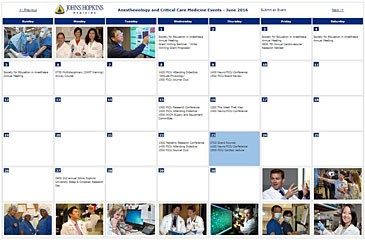What We Do:
The Quality Research Core (QRC) is one of 6 research pillars within ACCM that creates a robust infrastructure for research within Johns Hopkins Medicine.Mission:
To organize, fund, train and equip members of ACCM to produce world-class, academically rigorous quality and safety research.Vision:
To be worldwide leaders in quality and safety research and implementation science in the field of peri-operative medicine.Congratulations QRC micro-grant winners!
After a robust response to the RFP, it gives us great pleasure to announce the winners of the Quality Research Core (QRC) micro grants.
Dr. Jeff Dodd-O: Can the CPB-related Change in Diastolic Function Help Match Vulnerable Patients To Care Plans That will Improve Recovery?
Drs. Samuel Vanderhoek and Risa Wolf: Perioperative Glycemic Control in Non-Diabetic Children Undergoing Non-Cardiac Surgery
Dr. Nadia Hensley: Cluster RCT in a learning health system
Dr. Jochen Steppan: Incidence of Adverse events and Intraoperative Management of Pulmonary Hypertensive crisis in patients with Vein of Galen Malformation: A Quality Improvement Project
Dr. Sinead Nyhan: Factors influencing perioperative outcomes in pulmonary hypertension patients
We look forward to seeing the fruits that these seed monies will bear. Congratulations to the recipients.
To those with a quality or safety research idea, please don’t hesitate to reach out to the QRC. Together we are building the world’s most influential quality research core.
Nadia Hensley: Blood Administration in the OR
Background: Manual visual and verbal pre-transfusion checks of patient identification and blood product match are vulnerable to human error. Moreover, the dynamic and complex perioperative environment is fraught with patient safety risks. Subtle breakdowns in process owing to provider multitasking, patient acuity, and more can go unnoticed and result in patient harm. An ABO-incompatible blood transfusion at our institution launched an intraoperative initiative to leverage technology to improve patient safety.
Methods: A multidisciplinary team led a four-phase implementation of bedside barcode transfusion verification (BBTV) for intraoperative blood product administration. Manual random sample audits of blood component transfusions were used to examine accuracy of documentation from July 2014 until June 2016. After we transitioned to the Epic anesthesia information management system (AIMS) in July 2016, automated Epic reports were generated to provide population-level audits.
Results: After initiation of BBTV and the addition of Epic AIMS, we improved to >96% compliance with obtaining three metrics on documentation of patient identification: two electronic signatures, start and stop times of transfusion, and blood volume transfused. Pre-Epic audits had shown a mean compliance of only 87%, mainly owing to a lack of paper blood component requisitions. Only by creating a novel process within the Epic AIMS were we able to sustain success with these metrics at >96%.
Conclusion: By implementing BBTV and using a novel intraoperative documentation process within the Epic AIMS, we were able to initiate a safer process of blood transfusion in the operating rooms and improve documentation.
Quality Research Core Leadership
 | Medical Director of Quality Research Core Professor |
 | Director of Clinical Quality and Patient Safety Associate Professor |
